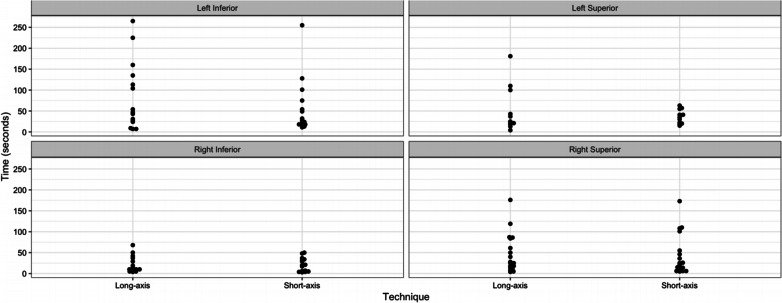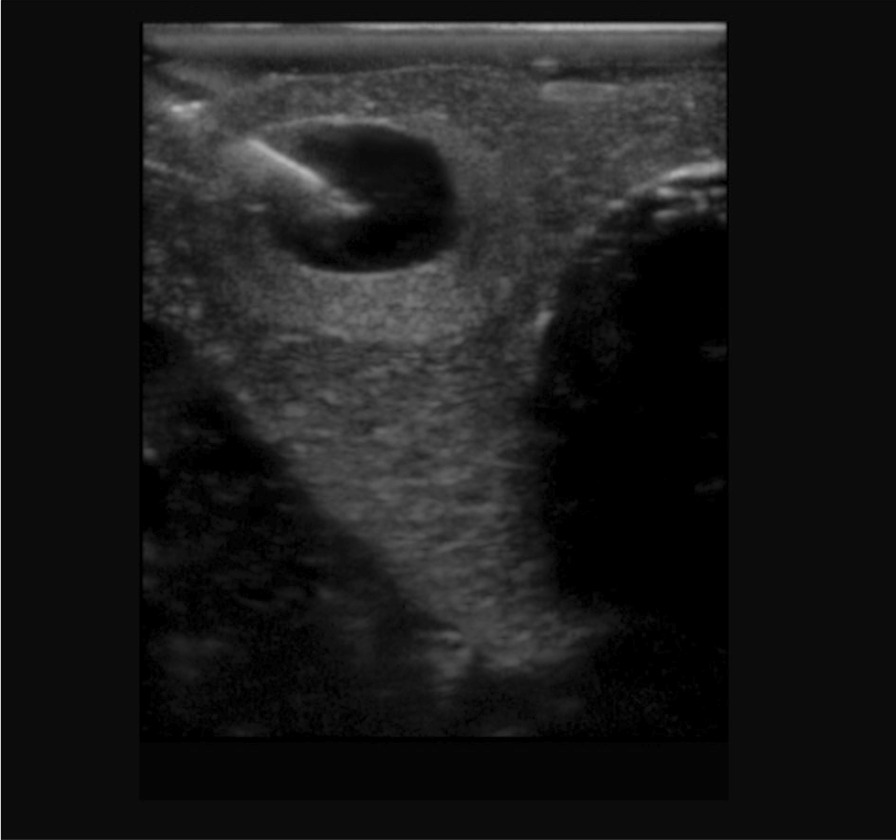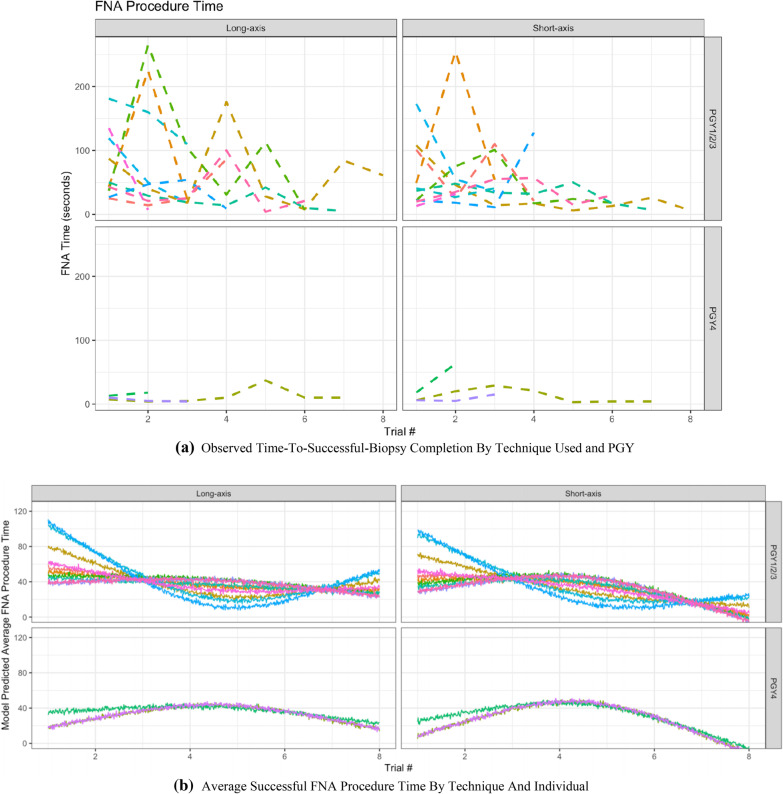Shireen Samargandy, Justine Philteos, Mirko Manojlovic Kolarski, Jason Xu, Eric Monteiro, Allan Vescan
下载PDF
{"title":"坐标轴之战:基于模拟的甲状腺结节细针穿刺活检评估。","authors":"Shireen Samargandy, Justine Philteos, Mirko Manojlovic Kolarski, Jason Xu, Eric Monteiro, Allan Vescan","doi":"10.1186/s40463-022-00587-5","DOIUrl":null,"url":null,"abstract":"<p><strong>Importance: </strong>Ultrasound-guided fine-needle aspiration biopsies (UGFNA) play a crucial role in the diagnosis of thyroid nodules. There are two techniques for performing an UGFNA: short-axis technique and long-axis technique. There is sparsity in the literature regarding the differences between these two techniques.</p><p><strong>Objective: </strong>To compare the efficiency between long-axis and short-axis thyroid UGFNA techniques in trainees. Our secondary outcomes were to define the comfort level and learning curves of trainees.</p><p><strong>Design: </strong>A longitudinal prospective cohort study, completed from December 2018 to November 2019, using the Blue Phantom Thyroid Model© for UGFNA. Face and construct validity of the model were verified. Residents completed UGFNA on an assigned nodule using both long-axis and short-axis techniques, the order of which was sequentially allocated. The rate and time to successful biopsy were obtained for both techniques. Biopsy attempts were repeated to establish learning curves.</p><p><strong>Setting: </strong>Single-center study.</p><p><strong>Participants: </strong>Fourteen Otolaryngology-Head & Neck Surgery residents at the University of Toronto.</p><p><strong>Main outcome measure: </strong>Biopsy success and efficiency for novice learners completing UGFNA on a simulated thyroid model using long-axis and short-axis techniques.</p><p><strong>Results: </strong>A trend towards higher odds of successful biopsy using the long-axis technique with no difference in procedure duration was observed (OR = 2.2, p = 0.095, CI = 0.87-5.39). Learning curve graphs appeared heterogenous according to trainee level. Trainees found the long-axis technique easier to perform (10/14, 71%), and the simulator valuable for learning (12/14, 86%).</p><p><strong>Conclusion: </strong>Thyroid UGFNA using the long-axis technique may have an increased success rate and is generally favored by trainees for being easier to perform. Thyroid simulators have the potential to increase learner comfort and efficiency with UGFNA.</p>","PeriodicalId":520683,"journal":{"name":"Journal of otolaryngology - head & neck surgery = Le Journal d'oto-rhino-laryngologie et de chirurgie cervico-faciale","volume":" ","pages":"32"},"PeriodicalIF":2.2000,"publicationDate":"2022-08-19","publicationTypes":"Journal Article","fieldsOfStudy":null,"isOpenAccess":false,"openAccessPdf":"https://www.ncbi.nlm.nih.gov/pmc/articles/PMC9392298/pdf/","citationCount":"1","resultStr":"{\"title\":\"Battle of the axes: simulation-based assessment of fine needle aspiration biopsies for thyroid nodules.\",\"authors\":\"Shireen Samargandy, Justine Philteos, Mirko Manojlovic Kolarski, Jason Xu, Eric Monteiro, Allan Vescan\",\"doi\":\"10.1186/s40463-022-00587-5\",\"DOIUrl\":null,\"url\":null,\"abstract\":\"<p><strong>Importance: </strong>Ultrasound-guided fine-needle aspiration biopsies (UGFNA) play a crucial role in the diagnosis of thyroid nodules. There are two techniques for performing an UGFNA: short-axis technique and long-axis technique. There is sparsity in the literature regarding the differences between these two techniques.</p><p><strong>Objective: </strong>To compare the efficiency between long-axis and short-axis thyroid UGFNA techniques in trainees. Our secondary outcomes were to define the comfort level and learning curves of trainees.</p><p><strong>Design: </strong>A longitudinal prospective cohort study, completed from December 2018 to November 2019, using the Blue Phantom Thyroid Model© for UGFNA. Face and construct validity of the model were verified. Residents completed UGFNA on an assigned nodule using both long-axis and short-axis techniques, the order of which was sequentially allocated. The rate and time to successful biopsy were obtained for both techniques. Biopsy attempts were repeated to establish learning curves.</p><p><strong>Setting: </strong>Single-center study.</p><p><strong>Participants: </strong>Fourteen Otolaryngology-Head & Neck Surgery residents at the University of Toronto.</p><p><strong>Main outcome measure: </strong>Biopsy success and efficiency for novice learners completing UGFNA on a simulated thyroid model using long-axis and short-axis techniques.</p><p><strong>Results: </strong>A trend towards higher odds of successful biopsy using the long-axis technique with no difference in procedure duration was observed (OR = 2.2, p = 0.095, CI = 0.87-5.39). Learning curve graphs appeared heterogenous according to trainee level. Trainees found the long-axis technique easier to perform (10/14, 71%), and the simulator valuable for learning (12/14, 86%).</p><p><strong>Conclusion: </strong>Thyroid UGFNA using the long-axis technique may have an increased success rate and is generally favored by trainees for being easier to perform. Thyroid simulators have the potential to increase learner comfort and efficiency with UGFNA.</p>\",\"PeriodicalId\":520683,\"journal\":{\"name\":\"Journal of otolaryngology - head & neck surgery = Le Journal d'oto-rhino-laryngologie et de chirurgie cervico-faciale\",\"volume\":\" \",\"pages\":\"32\"},\"PeriodicalIF\":2.2000,\"publicationDate\":\"2022-08-19\",\"publicationTypes\":\"Journal Article\",\"fieldsOfStudy\":null,\"isOpenAccess\":false,\"openAccessPdf\":\"https://www.ncbi.nlm.nih.gov/pmc/articles/PMC9392298/pdf/\",\"citationCount\":\"1\",\"resultStr\":null,\"platform\":\"Semanticscholar\",\"paperid\":null,\"PeriodicalName\":\"Journal of otolaryngology - head & neck surgery = Le Journal d'oto-rhino-laryngologie et de chirurgie cervico-faciale\",\"FirstCategoryId\":\"3\",\"ListUrlMain\":\"https://doi.org/10.1186/s40463-022-00587-5\",\"RegionNum\":0,\"RegionCategory\":null,\"ArticlePicture\":[],\"TitleCN\":null,\"AbstractTextCN\":null,\"PMCID\":null,\"EPubDate\":\"\",\"PubModel\":\"\",\"JCR\":\"\",\"JCRName\":\"\",\"Score\":null,\"Total\":0}","platform":"Semanticscholar","paperid":null,"PeriodicalName":"Journal of otolaryngology - head & neck surgery = Le Journal d'oto-rhino-laryngologie et de chirurgie cervico-faciale","FirstCategoryId":"3","ListUrlMain":"https://doi.org/10.1186/s40463-022-00587-5","RegionNum":0,"RegionCategory":null,"ArticlePicture":[],"TitleCN":null,"AbstractTextCN":null,"PMCID":null,"EPubDate":"","PubModel":"","JCR":"","JCRName":"","Score":null,"Total":0}
引用次数: 1
引用
批量引用
Battle of the axes: simulation-based assessment of fine needle aspiration biopsies for thyroid nodules.
Importance: Ultrasound-guided fine-needle aspiration biopsies (UGFNA) play a crucial role in the diagnosis of thyroid nodules. There are two techniques for performing an UGFNA: short-axis technique and long-axis technique. There is sparsity in the literature regarding the differences between these two techniques.
Objective: To compare the efficiency between long-axis and short-axis thyroid UGFNA techniques in trainees. Our secondary outcomes were to define the comfort level and learning curves of trainees.
Design: A longitudinal prospective cohort study, completed from December 2018 to November 2019, using the Blue Phantom Thyroid Model© for UGFNA. Face and construct validity of the model were verified. Residents completed UGFNA on an assigned nodule using both long-axis and short-axis techniques, the order of which was sequentially allocated. The rate and time to successful biopsy were obtained for both techniques. Biopsy attempts were repeated to establish learning curves.
Setting: Single-center study.
Participants: Fourteen Otolaryngology-Head & Neck Surgery residents at the University of Toronto.
Main outcome measure: Biopsy success and efficiency for novice learners completing UGFNA on a simulated thyroid model using long-axis and short-axis techniques.
Results: A trend towards higher odds of successful biopsy using the long-axis technique with no difference in procedure duration was observed (OR = 2.2, p = 0.095, CI = 0.87-5.39). Learning curve graphs appeared heterogenous according to trainee level. Trainees found the long-axis technique easier to perform (10/14, 71%), and the simulator valuable for learning (12/14, 86%).
Conclusion: Thyroid UGFNA using the long-axis technique may have an increased success rate and is generally favored by trainees for being easier to perform. Thyroid simulators have the potential to increase learner comfort and efficiency with UGFNA.




 求助内容:
求助内容: 应助结果提醒方式:
应助结果提醒方式:


